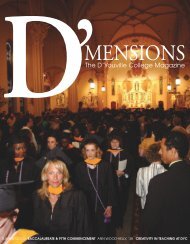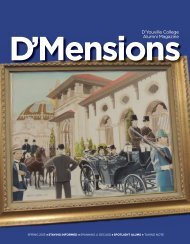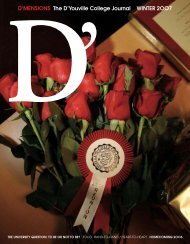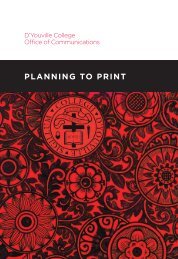d'mensions D'Youville college Journal august 2o11
d'mensions D'Youville college Journal august 2o11
d'mensions D'Youville college Journal august 2o11
- No tags were found...
You also want an ePaper? Increase the reach of your titles
YUMPU automatically turns print PDFs into web optimized ePapers that Google loves.
accalWithout question, the emotional climax of graduation week is the interfaithbaccalaureate ceremony, rich with symbolism and glowing with thebrilliant colors of academic regalia.Academic garb may go back to the early Middle Ages, to a time in Europeof widespread workers’ guilds – such as brick- or stonemasons – whichwere formed by the skills they held in common. Gradually, an occasionalpiece of clothing became indicative of a member’s expertise. Possiblyfrom this beginning, jackets with deep folded collars at the back(a precursor to hoods) were added, and then, in the 1200s and 1300swhen medieval scholars were mostly clergymen and universitieswere primarily education guilds, the black gown was added.It was not until the 1800s that the stiff mortarboard cap wasintroduced, which exactly mimics the brick- or stonemason’shandheld tool, a flat square board used for mixing mortar.Over time, each field of study has become identified byits own hood color, e.g., liberal arts (white), education(light blue), nursing (apricot), physical therapy (sagegreen), accounting and business (brown), chiropractic(silver) and science (gold). Hoods of varying lengthsindicate the level of study: bachelor’s degree, tomid-upper back; master’s degree, to the waist;and doctoral degree to the back-of-the-knees.In guild language, the term “bachelor” denotedapprentice;“master,” a full member of the guild;and “doctor,” the highest degree of learningin a specific field of study.8
















